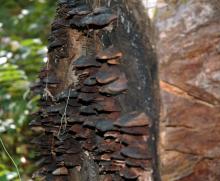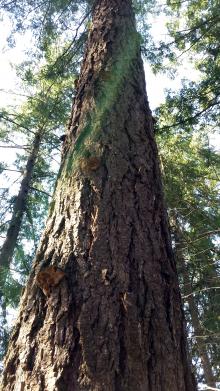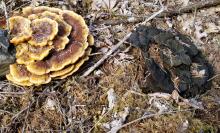Cause Stem decay in living trees is caused by various fungi that enter trees through wounds or small branches. Decay fungi usually do not kill trees but trees, which are affected, are structurally weakened and more likely to break during storms or harvest. Decayed trees can be a serious hazard when near roads, buildings or developed recreation areas. Decay in living trees can also provide important wildlife habitat. Many different trees have decay problems; however, non-resinous species such as true firs, hemlocks and hardwoods have more decay than resinous species such as Douglas-fir, pines and larch.
Wounds can activate dormant infections and provide openings for spores to create new infections. Basal wounds generally have more decay than upper stem wounds. Older trees tend to have more decay as well. Living trees will actively compartmentalize decay columns limiting the amount within the stem. If you see a fungal conk on the trunk of a tree, the rule of thumb is that the decay column or cull factor is about 8 feet below (and/or above) the fruiting body. The CODIT model/principle (compartmentalization of decay in trees) is used by certified arborists to manage landscape trees with decay.
Brown Trunk Rot - Fomitopsis officinalis (sometimes called the quinine fungus) - is a problem on Douglas-fir, pine and larch.
Red Ring Rot (sometimes called white speck) - Porodaedalea pini (formerly Phellinus pini) - is a problem on Douglas-fir, grand fir, white fir, mountain hemlock and pine.
Rosey Top Rot (or Brown Top Rot) - Fomitopsis cajanderi - is a problem on many conifers that have storm damage and top breakage. This fungus and others colonize the damaged tissue.
Rust-red Stringy White Rot - Echinodontium tinctorium (sometimes called Indian paint fungus) - is a problem on true firs and mountain hemlock.
Schweinitzii Root and Butt Rot - Phaeolus schweinitzii (sometimes called the cow pie fungus) - is a problem on Douglas-fir, true firs, pine, larch and spruce.
Symptoms
Brown Trunk Rot - Brown cubical decay with white mycelial felts. Large, white to gray conks may develop on the stem.
Red Ring Rot - Initially there is a red stain in a ring when viewed in cross section. Then white, spindle-shaped pockets of decay (white specks) develop parallel to the wood grain. Wood may have a honeycombed appearance in advanced stages of decay. The decay column may extend several feet above or below a conk. Bracket-like gray to brown conks with golden-brown angular pores on the underside may be seen on the stem.
Rosey Top Rot - Brown cubical decay with white to faintly rose-colored mycelial felts. The rose-colored pore layer of fruiting bodies is distinctive for this disease.
Rust-red Stringy White Rot - Brown to reddish orange rot of the heartwood. The wood becomes stringy and eventually takes on a whitish cast in advanced stages of decay. Bright orange rusty pink knots may protrude from the bark and are a good indicator of the fungus. Large, black, hoof-shaped conks with red interior and "teeth" on the underside may be seen underneath dead branch stubs.
Schweinitzii Root and Butt Rot - Brown cubical decay of the heartwood. The fungus produces a large yellow to brown conk with soft velvet top develop on the stem. The conk has a short stalk when growing on the ground (and looks like a cow pie) but is bracket-like when growing on a tree. Basal resinosis or pitching (large exudations of pitch at the base of the stem at or below the root collar) may also occur.
Cultural control The primary management tactic is to prevent tree wounds.
- Avoid spring and early summer logging, when bark is soft and loose.
- Mark "leave" trees rather than trees to be cut so that leave trees are easier to distinguish.
- Plan and mark skid trails before logging.
- Log skid trails first, then limb and top trees before skidding.
- Use directional falling and fell to openings.
- Remove slash within 10 feet of "leave" trees to reduce damage from natural or prescribed fires.
- If snags and decayed trees are desired, top trees just below the live crown, make hollows or slits at least 25 feet above the ground, or drill 1-inch diameter holes into the trunk at least 6-inches deep. A piece of plastic pipe in the hole will prevent the hole from being sealed with pitch or callus.
Reference Shaw, D.C., Oester, P.T. and Filip, G.M. 2009. Managing Insects and Diseases in Oregon Conifers. Oregon State University Extension Service. EM 8980.




